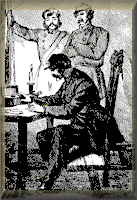USGenWeb Free Census Project Help, 1800 Census Help
Remember, please sign up with a State Census Coordinator before beginning a transcription.
The following following are available to our volunteer transcribers so that our file managers can convert them to the standardized text output to meet the goals of the project.
- CENTRANS (MAC & PC) Centrans Instructions and Help
- We have the following templates available for download: MSExCel Spreadsheet | MSWorks Spreadsheet | Tab Text Templates [Note: These are zipped and are also available by request from Maggie Stewart. Please use "templates" as the subject of your email and include what year and type of template that you need.]
Before you begin transcribing, you may want to look at Old Handwriting to see examples of old writing styles.
Most columns of the census from 1790 - 1840 used a "fence post tally". The census had anywhere from 7 to 32 questions, but the census taker used only the ones he needed. Do not be alarmed if the census you are working on does not have all of the categories.
VERY IMPORTANT
If a date is unreadable, you should replace the unreadable numbers with an asterisk(*). For example, "18*9". Make a note of it in the remarks column.
If a text field is unreadable, enter the letter "U" in the smaller fields and the word "Unreadable" in the larger fields. Make a note of it in the remarks column.
Enter exactly what you see in each field unless noted below. Avoid the urge to correct the census taker's errors.
Never use ditto(") marks in any fields. The search engine will not understand them. Replace the ditto(") marks with the word they were used for.
If any of the fields in the census have a checkmark or some other non-letter mark, you may replace it with an "X".
Census Year: You need to type in the year you are working on. This will only need to be done once per template.
Reel/Microfilm #: Enter the reel # or microfilm # of the census you are working on.
State: Enter the state you are working on.
County: Enter the county listed.
District: At the top of the census page, it may read "Inhabitants of _________, county of" or it may read "by the Marshall of _________ Division (or Territory)". The word after "Inhabitants of" or "Marshall of" is what you need to enter.
Enumerator: At the top you the census page, it may say "Schedule of the whole number of persons within the division allotted to _________." This is the enumerator.
Page #: After the census was finished, the pages were bound into books with two pages facing each other and a page number was stamped on the upper right hand corner, leaving the other page blank. The pages are now known as A and B pages (for example: 17A and 17B). When the census was microfilmed, the photographers wrote numbers in pencil, which are often out of order. In the field for page numbers, you will enter the STAMPED number including the A or the B after the number AND in the remarks section for the first person you enter on each page, note what the handwritten page number is. An example would "Handwritten page # 1". For more on page numbers, see the FAQs.
Line #: With a template, you will need to enter each line number as you enter each new person. Many of the 1790 - 1840 census pages did not have line numbers. If the census you are working on does not have line numbers, you should make your own starting with #1 for each page.
Name of Head of Family: You are going to separate the name into two columns on the template: "Surname" (last name) and "Given name" (first and middle names). These must be entered EXACTLY as you see them. Even if it is your own family and the name is misspelled, avoid the urge to change it. If there are ditto(") marks or a dash(-) indicating the same last name as the previous person, enter the name that the ditto(") marks or dash(-) are referring to. If any of the letters are unreadable, use an asterisk(*) instead of the letter. For example, Jo*nso*. If you do this, you should put a note in the remarks section that some letters were unreadable. Place titles, such as Jr., Sr., Dr., etc. at the end of the person's first name(s) - Doe, John Sr. If the given name is abbreviated, such as "Geo." or "Wm", please enter exactly as it appears.
VERY IMPORTANT - The ONLY time you will enter "NS" (No Surname) is if they are listed as these examples: "Brother Ignatius"; "Sister Mary"; Native American names such as "Running Doe"; or servants, such as "John, a man of color".
Free White Males: Six columns. If a column is empty, please enter a "0"(zero). (Names of Columns: under 10 years, of 10 and under 16, of 16 and under 26, of 26 and under 45, of 45 and upwards)
Free White Females: Six columns. If a column is empty, please enter a "0"(zero). (Names of Columns: under 10 years, of 10 and under 16, of 16 and under 26, of 26 and under 45, of 45 and upwards)
Free Persons, Except Indians (not taxed): Enter the number listed. If there is no entry, enter a "0"(zero).
Slaves: Enter the number listed. If there is no entry, enter a "0"(zero).
Totals: Totals are given at the end of each column and you should enter the number seen. However, not all censuses have the totals recorded. If there is no total on the census you are doing, make a note in the remarks section.
Remarks/Reference: This is for your remarks about unreadable dates, text, etc. You may need to make comments about the entries, note what the handwritten page number is or anything else you feel is important.


